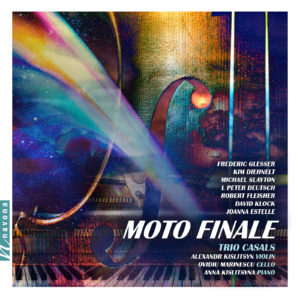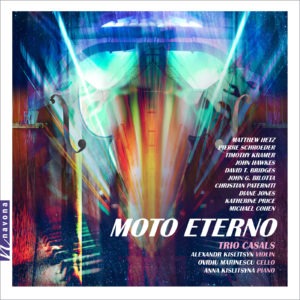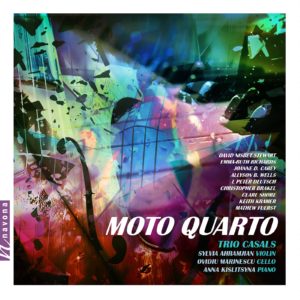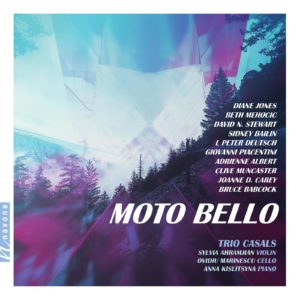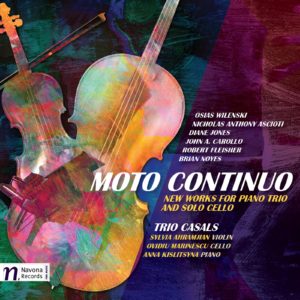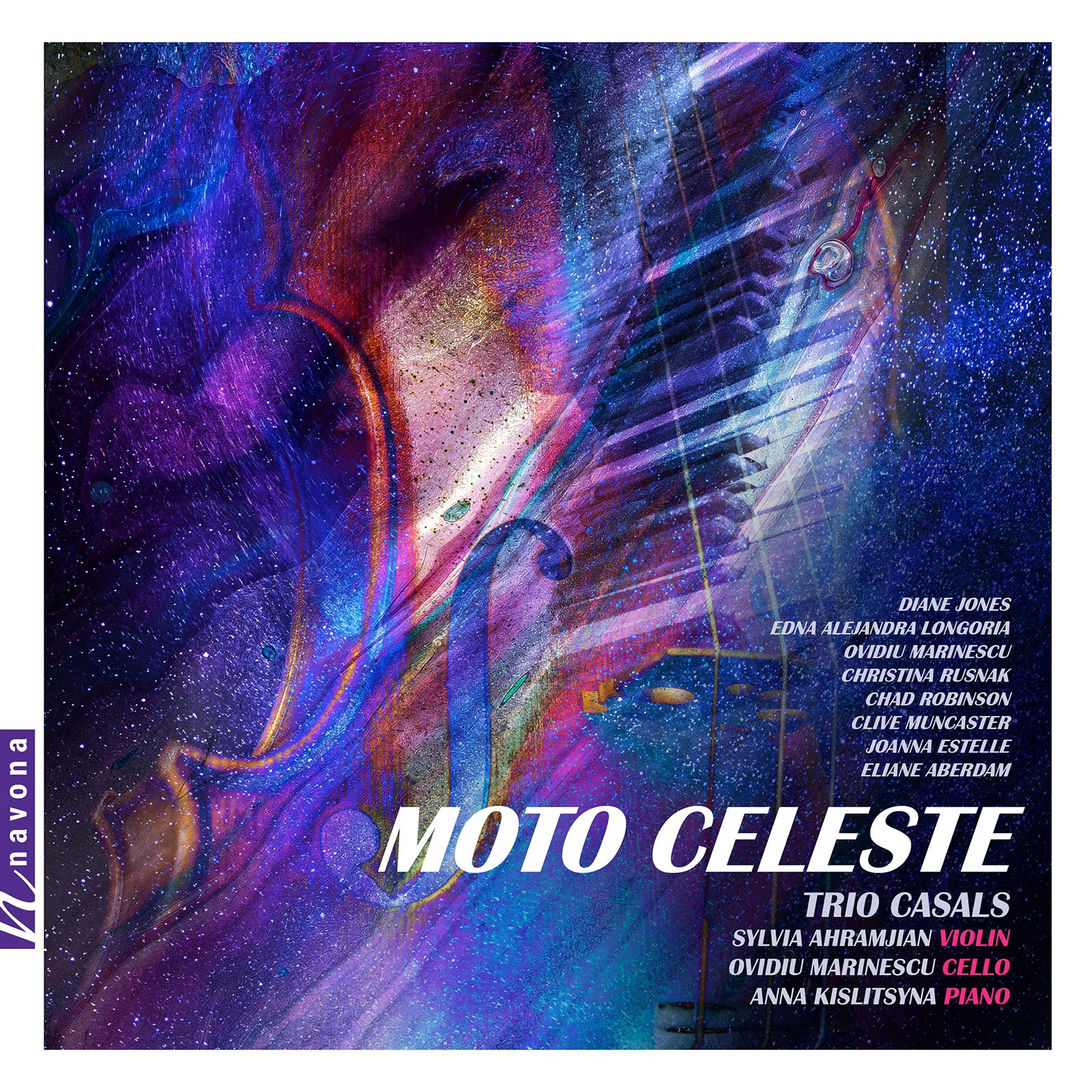
Share Album:
Moto Celeste
Diane Jones composer
Edna Alejandra Longoria composer
Ovidiu Marinescu composer
Christina Rusnak composer
Chad Robinson composer
Clive Muncaster composer
Joanna Estelle composer
Eliane Aberdam composer
Trio Casals
Sylvia Ahramjian violin
Ovidiu Marinescu cello
Anna Kislitsyna piano
In MOTO CELESTE, the fifth installment in Navona Records’ MOTO series, the internationally-acclaimed Trio Casals takes on eight new works by eight preeminent composers. It is an electrifying collection, full of drama and adventure. The compositions borrow from an eclectic array of musical traditions, including rhumba and flamenco music. MOTO CELESTE is forged into a cohesive work by the trio’s sensitive and highly-organic performances.
Earth Rise by composer Diane Jones kicks off the recording. This piece is inspired by the cosmic dance between the sun, moon, and Earth, and features lively dances and ethereal strains. Next comes Edna Longoria’s Los Ritmos Para Tres, which translates to “rhythms for three.” It is a mischievous and thrilling piece, rife with shadow and mystery. Ovidiu Marinescu, Trio Casals’ cellist, composed I’m All Ears, which is inspired in part by the musical gestures of a flamenco guitar and features a muscular performance by Marinescu. Next comes Christina Rusnak’s Glacier Blue, in which the trio reflects on the fundamental physical elements of “Mountain,” “Sky,” and “Water” over the course of three movements. Darkbloom by Chad Robinson follows, exploring the full range of the cello with boisterous interjections and tentative replies. After that comes Clive Muncaster’s Palette No. 2, a grand, sweeping piece seasoned with cross rhythms and even rhumba-inspired passages. The penultimate track is Joanna Estelle’s Faraway Star, which includes songful themes that passionately recount the story of two (literally) star-crossed lovers. Finally, Eliane Aberdam’s Grisailles Vaporeuses or “misty grayness” is a three-movement work inspired by nature in New England, with all its joy and drama. The piece ends without a firm musical resolution, leaving the listener already longing for the next album in the MOTO series.
Classical music aficionados and casual listeners alike will find themselves drawn in by the Trio Casal’s powerhouse performances in MOTO CELESTE. With precision and grace, these three artists, fueled by the collective genius of eight individual composers, offer a musical experience to be relived again and again.
Listen
Stream/Buy
Choose your platform
"Each work is a masterpiece."
An Inside Look
PARMA Recordings Presents - MOTO CELESTE
Track Listing & Credits
| # | Title | Composer | Performer | |
|---|---|---|---|---|
| 01 | Earth Rise | Diane Jones | Trio Casals | 9:54 |
| 02 | Los ritmos para tres | Edna Alejandra Longoria | Trio Casals | 5:54 |
| 03 | Sunt Numai Urechi | Ovidiu Marinescu | Trio Casals | 7:17 |
| 04 | Glacier Blue: I. Mountain | Christina Rusnak | Trio Casals | 4:07 |
| 05 | Glacier Blue: II. Sky | Christina Rusnak | Trio Casals | 5:28 |
| 06 | Glacier Blue: III. Water | Christina Rusnak | Trio Casals | 4:36 |
| 07 | Darkbloom | Chad Robinson | Trio Casals | 9:08 |
| 08 | Palette No. 2 | Clive Muncaster | Trio Casals | 7:42 |
| 09 | Faraway Star | Joanna Estelle | Trio Casals | 3:24 |
| 10 | Grisailles vaporeuses: I. Pensive | Eliane Aberdam | Trio Casals | 3:44 |
| 11 | Grisailles vaporeuses: II. Lyrical | Eliane Aberdam | Trio Casals | 2:44 |
| 12 | Grisailles vaporeuses: III. Joyful | Eliane Aberdam | Trio Casals | 2:17 |
Recorded May 11-12, 30-31, and June 1, 2019 at Futura Productions in Roslindale MA Recording Session Producer Brad Michel (tracks 1-2, 6-10)
Recording Session Producer John Weston (tracks 3-5)
Recording Session Engineer John Weston
Executive Producer Bob Lord
Executive A&R Sam Renshaw
A&R Director Brandon MacNeil
A&R Danielle Lewis, Chris Robinson, Marina Altschiller
VP, Audio Production Jeff LeRoy
Audio Director, Editing (Tracks 3-7) Lucas Paquette
Editing (Tracks 1, 2, 8-12), Mixing & Mastering Brad Michel
Recording Sessions Director, Editing (Tracks 4-6) Levi Brown
Recording Sessions Assistant Emma Terrell
VP, Design & Marketing Brett Picknell
Art Director Ryan Harrison
Design Edward A. Fleming
Publicity Patrick Niland, Sara Warner
Artist Information

Diane Jones
Diane Jones’ music has been performed by The Relâche Ensemble, The Da Capo Chamber Players, Trio Casals, and Flautet. She has been commissioned by Mélomanie, the Society for New Music, and the Matilda Joslyn Gage Foundation, and she recently completed a commission from the Syracuse International Film Festival to score the 1919 silent film, “The Doll,” screened during the 2019 festival with a live ensemble.
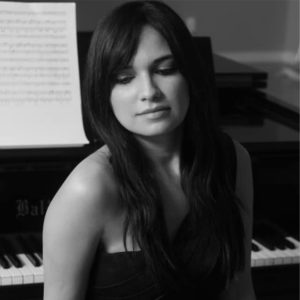
Edna Alejandra Longoria
Edna Alejandra Longoria is a Mexican-American composer born in Mcallen TX and raised in Reynosa, Tamaulipas, México. Longoria obtained a master’s degree in Music Composition at the Bob Cole Conservatory of Music at California State University in Long Beach, and a bachelor’s degree in Music Composition from the University of Texas at San Antonio.
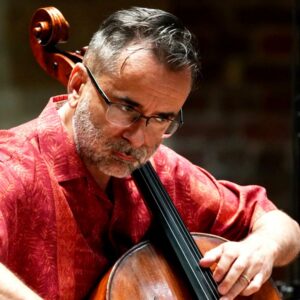
Ovidiu Marinescu
Ovidiu Marinescu is internationally recognized as a cellist, composer, conductor, and educator. He has performed at Carnegie Hall, Weill Hall, Merkin Hall (New York), the Great Hall of the Moscow Conservatory, Holywell Room in Oxford, Oriental Art Center in Shanghai, and has appeared as soloist with the London Symphony, New York Chamber Symphony, the National Radio Orchestra of Romania, Moscow Chamber Orchestra, Helena, Great Falls, Portsmouth, and Newark Symphonies, Southeastern Pennsylvania Symphony Orchestra, Cleveland Philharmonic, Limeira Symphony in Brazil, Orquesta de Extremadura in Spain, and most of the professional orchestras in his native Romania. The album LONDON CELLO CONNECTION features Marinescu and London Symphony Orchestra in eight newly-commissioned cello concertos by North American composers.
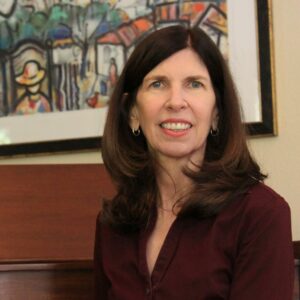
Christina Rusnak
Inspired by concepts of place and the human experience, composer Christina Rusnak works at the intersection of nature, culture, history, landscape, and art to integrate context into her music from the world around her. Rusnak composes for diverse instrumentations with lyrical lines, and organic rhythms and textures. Her pieces range from elementary to professional levels and includes chamber ensemble, orchestra, wind band, choral and solo works, as well as flex band pieces, jazz, electro-acoustic works, and film.

Chad Robinson
Houston native Dr. Chad Robinson is the Artistic Director and founder of Texas New Music Ensemble, a Houston-based mixed chamber ensemble focused solely on the work of Texas composers. As a composer, he has worked with many other prestigious ensembles and soloists, such as Ethel, Lontano, The Jack Quartet, The Parker Quartet, Musiqa, George Vosburgh, Mary Dullea, and Emma Steele.
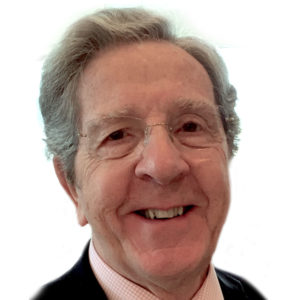
Clive Muncaster
Clive Muncaster was born on January 24, 1936. At the young age of 15, he was accepted into the Royal Academy of Music where he studied violin, piano, composition, and conducting, and earned his Royal Academy of Music Licentiate Diploma (LRAM). In the 1960s Chandos Music published some of his compositions, which received many broadcasts in England and Germany.
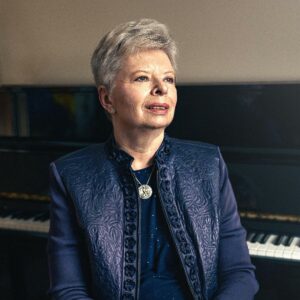
Joanna Estelle
Joanna Estelle (Storoschuk) is a Canadian composer, lyricist, and arranger, born of Ukrainian parentage. Her music has won critical acclaim from Parliament Hill, Ottawa (Canada) to London (United Kingdom), Barcelona (Spain), Carnegie Hall (New York City), and elsewhere around the world. Estelle studied classical piano and theory with the Royal Conservatory of Music (Toronto) as a young person, but her parents deterred her from pursuing music as a career. Instead, she graduated in Psychology and English (Brock, 1972), then went on to study management accounting. However, her enthusiasm for music never waned.

Eliane Aberdam
Eliane Aberdam was born in Nancy, France. She studied piano and theory at the Conservatoire National de Region in Grenoble (1972-1981). She completed her undergraduate studies in composition at the Rubin Academy of Music and Dance in Jerusalem, Israel, where she studied with Mark Kopytman. In 1989, she entered the graduate program at the University of Pennsylvania where she studied with George Crumb, and obtained her master’s degree in 1992. She completed her Ph.D. in Composition at U.C. Berkeley.
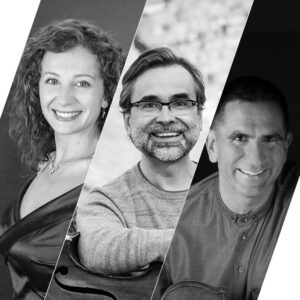
Trio Casals
Since making a highly-praised debut at the 1996 edition of the Pablo Casals Festival in Puerto Rico, Trio Casals has delighted audiences with spectacular virtuosity, engaging enthusiasm, and exquisite musical elegance. The ensemble released several commercial albums with PARMA Recordings and Navona Records to critical acclaim with Ovidiu Marinescu and past members including Anna Kislitysyna, Alexandr Kislitsyn, and Sylvia Ahramjian, from the beloved MOTO series to A GRAND JOURNEY and more. Marinescu remains in the current ensemble line up, with Mădălina-Claudia Dănilă and Timothy Schwarz joining in 2024.
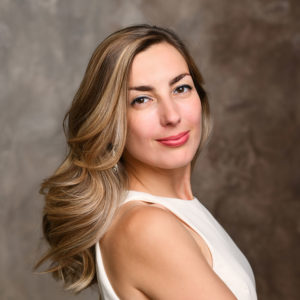
Anna Kislitsyna
Pianist and harpsichordist Anna Kislitsyna made her solo debut at age 10 with the Omsk Symphony Orchestra. She remains in high demand as a soloist, collaborative pianist, and educator. Recent season highlights include five new album productions with PARMA Recordings and two release concerts in Carnegie Hall’s Weill Recital Hall, performing Haydn and Shostakovich Piano Concertos with Helena Symphony and Southeastern Pennsylvania Symphony Orchestra, and returning to the Omsk Philharmonic as a soloist to give the inaugural performance on the new harpsichord.
